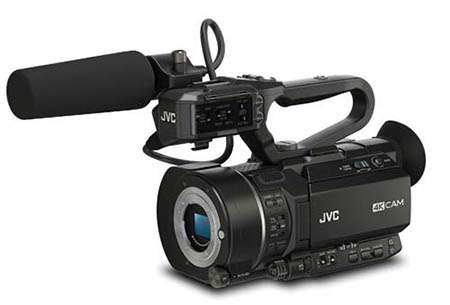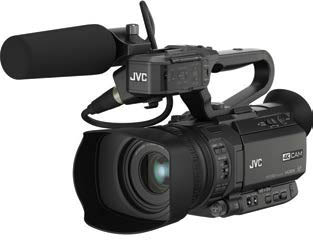NAB 2015: JVC Touts 4K, ENG Strengths

JVC’s GY-LS300 4KCAM Super 35mm Camcorder is the flagship product in the company’s 4KCAM line and sports a large imager with interchangeable lenses
LAS VEGAS—Although it’s not ignoring the existing business it does with 1/3-inch camcorders for news and studio work, JVC has started to march in the 4K direction.
“Everybody assumes [4K] is going to happen, and they want to be ready for it,” said Dave Walton, assistant vice president for marketing communications at JVCKenwood USA. “We now have a 4K product line—three cameras in a family that can produce very nice ultra HD recordings. And they can also be used today in the HD realm.”
JVC’s GY-LS300 4KCAM Super 35mm Camcorder is the flagship product in the company’s 4KCAM line and sports a large imager with interchangeable lenses. The camcorder features a 4K Super 35mm CMOS sensor and MFT lens mount and utilizes Variable Scan Mapping technology to maintain the native angle of view for lenses from the Super35, Super16, MFT, and other lens families. It also features built-in HD streaming and records 4K Ultra HD or Full HD.

JVC’s GY-HM200 4KCAM Streaming Camcorder Second in the line is the GY-HM200 4KCAM Streaming Camcorder, JVC’s most affordable streaming camcorder, capable of delivering 4K Ultra HD, Full HD, and SD imagery with a 1/2.3-inch BSI CMOS chip. It features a built-in 12x zoom lens with optical image stabilizer.
Rounding out the family, JVC will showcase its GY-HM170 4KCAM Compact Camcorder, which records 4K Ultra HD as H.264 files, and can record HD and SD footage in a variety of resolutions and frame rates.
4K FOR BROADCAST? START PLANNING NOW
Walton doesn’t see 4K news coverage any time soon, but he makes a case for stations to begin planning. “4K can be very beneficial to the broadcaster, because broadcasters do more than ENG, they also do production work,” he said. “We’ve seen a desire among broadcasters to use a larger imager to get a lush cinematic look to some of their production work.”
Get the TV Tech Newsletter
The professional video industry's #1 source for news, trends and product and tech information. Sign up below.
Even with all the company’s excitement over its new 4K cameras, Walton hasn’t forgotten that JVC has found a nice business niche for its 1/3-inch camcorders: broadcast newsrooms. “We’ve become virtually number one in the small to mid-sized markets throughout the country,” he said.
FIRST ON-AIR, FIRST ONLINE
This specialization in newsgathering camcorders spawned the company’s NAB slogan last year: “First on-air, first online.” Walton says it applies equally well this year.
“That is a theme that is derived from our dedication to the broadcast ENG market, and the uniqueness of our product’s ability to do live shots without encumbrances such as backpacks, microwave, satellite trucks or anything like that,” Walton said. Instead, JVC handles the streaming in the camera itself. The circuitry and the software contribute almost nothing to the weight of the camcorder, and integrate with it for operation.
“You can use an LTE modem or a WiFi hot spot, and you can stream live shots back to the station,” he said. “We have numerous stations using that now, and they really love it.”
Walton said that in addition to a lower pricepoint for 1/3-inch camcorders and the cellular liveshot capability that JVC’s been building into them, there’s yet another reason why they’re so popular for newsgathering.
“Where the large-sensor cameras have that shallow depth of field that provides the so-called ‘cinema look’ so popular in motion pictures these days, the 1/3-inch sensors have the opposite effect: a very deep depth of field,” he said. “In the run-and-gun world of news coverage, where you usually don’t have a second chance to get the shot, those cameras are much easier to keep in focus out in the field.”
JVC is in booth C4314 in the Central Hall of the LVCC.
